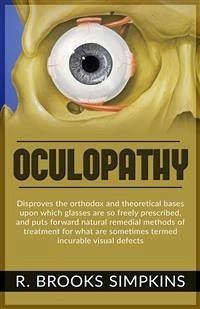The theory that longsight, shortsight, and astigmatism are incurable visual defects, even though they have developed in eyes which were normal at birth, has been maintained for a century — and has been, and still is, the basis upon which glasses are universally prescribed for young and old alike. Text books in many languages affirm that adjustment of the focus of the eyes depends solely upon the small natural lens inside the eye incessantly altering its strength for near and far vision. R. Brooks Simpkins has disproved these theories and in this work portrays how refractive errors develop, and also the manner in which the eye actually adjusts its focus for all ranges of vision. Diagrams are included which explain to those who prescribe glasses the irregular activity of the intracranial processes of vision primarily responsible for the 'external' refractive error - a field of knowledge hitherto mainly disregarded and unexplored. Remedial methods of treatment, other than glasses, are also indicated. The eyes can be trained scientifically to work in accordance with nature's design of the visual mechanism - this is of great importance to children and young adults, while the need for glasses can be postponed for the middle-aged. Good sight is to be cherished, and everyone has a vested interest, far surpassing other considerations, in his or her own eyes. It is the hope of the author of this book that increasing efforts will be made in schools, clinics and private practice to bring to as many as possible the joy of unaided normal vision.
Bitte wählen Sie Ihr Anliegen aus.
Rechnungen
Retourenschein anfordern
Bestellstatus
Storno









